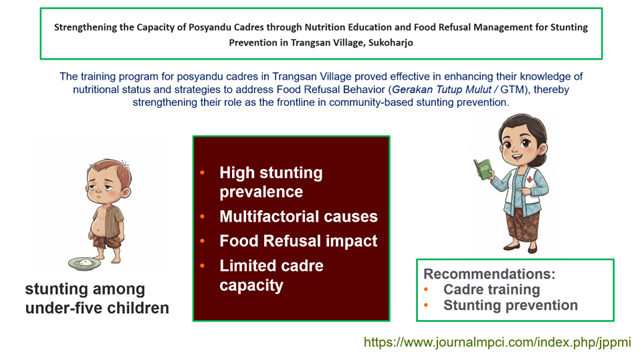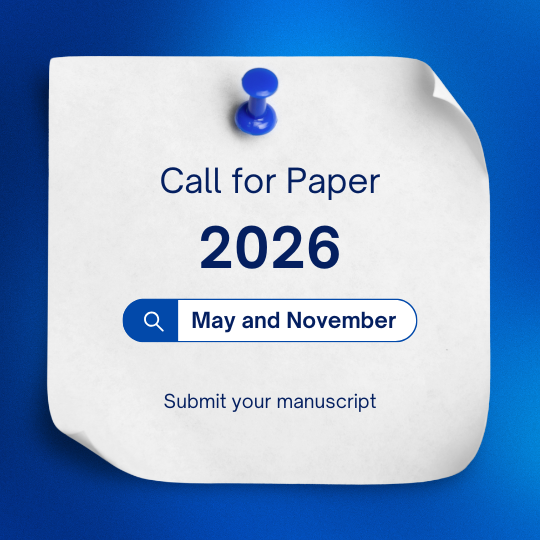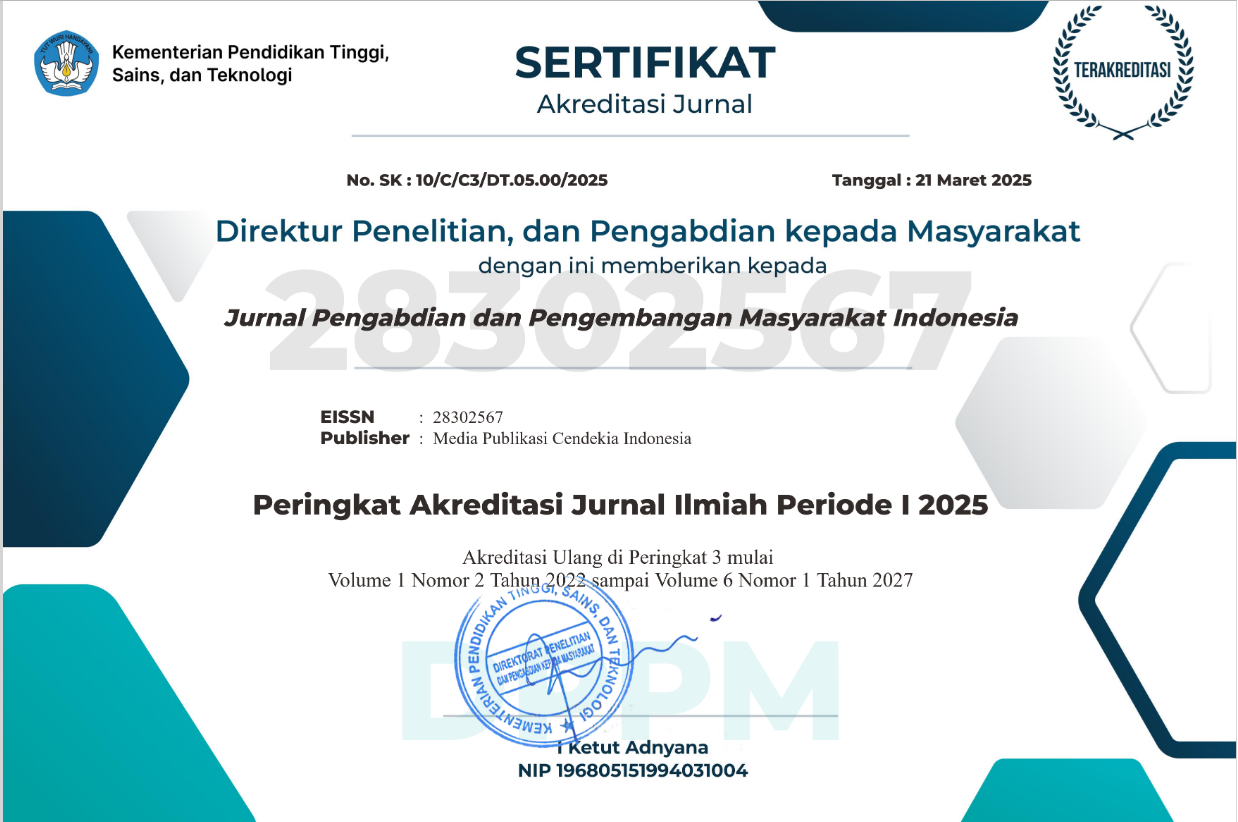Penguatan Kapasitas Kader Posyandu melalui Edukasi Gizi dan Penanganan Gerakan Tutup Mulut untuk Pencegahan Stunting di Desa Trangsan, Sukoharjo
Strengthening the Capacity of Posyandu Cadres through Nutrition Education and Food Refusal Management for Stunting Prevention in Trangsan Village, Sukoharjo
Keywords:
Stunting, Kader Posyandu, Status Gizi, Gerakan Tutup Mulut (GTM), Pelatihan KaderAbstract
Stunting masih menjadi masalah kesehatan masyarakat di Indonesia dengan prevalensi tinggi pada anak balita dan penurunan yang relatif lambat. Faktor penyebab mencakup gizi buruk, infeksi berulang, rendahnya pendidikan, kondisi sosial ekonomi, serta keterbatasan akses layanan kesehatan. Di Kecamatan Gatak, Sukoharjo, masalah stunting juga dipengaruhi oleh perilaku makan anak, termasuk fenomena Gerakan Tutup Mulut (GTM) yang berdampak pada status gizi dan tumbuh kembang balita. Kader posyandu memiliki peran strategis dalam deteksi dini dan pendampingan keluarga melalui edukasi serta konseling. Program pengabdian masyarakat di Desa Trangsan dilakukan dengan pelatihan pengukuran antropometri, edukasi status gizi, serta strategi penanganan GTM, diikuti oleh 31 kader posyandu. Hasil evaluasi menunjukkan peningkatan signifikan pengetahuan kader: pada tema status gizi nilai rata-rata meningkat dari 80,00 menjadi 90,32 (p=0,007), dan pada tema GTM dari 60,00 menjadi 87,74 (p=0,000). Pelatihan ini terbukti efektif meningkatkan kapasitas kader posyandu sebagai garda terdepan pencegahan stunting di masyarakat.
Downloads
References
Adam, A., Hartono, R., Salim, A., Irwan, Z., & Imran, A. (2020). Water and Microbial Contents in Moringa Oleifera Seed Flour as Food Supplement to Prevent Stunting. Systematic Reviews in Pharmacy, 11(10), 694–697. https://doi.org/10.31838/srp.2020.10.102
Adam, A., & Salim, A. (2018). Maternal education level and parental income toward stunting to students of salulayang elementary school in mamuju regency. Indian Journal of Public Health Research and Development, 9(12), 1367–1370. https://doi.org/10.5958/0976-5506.2018.02043.0
Agushybana, F., Siramaneerat, I., Raksamat, W., & Siriphakhamongkhon, S. (2018). Population-based survey of exclusive breastfeeding in Indonesia: A secondary analysis. Pacific Rim International Journal of Nursing Research, 22(1), 6–17. https://www.scopus.com/inward/record.uri?eid=2-s2.0-85060561636&partnerID=40&md5=5c98bade544d769ba862b287b06dea83
Aminabadi, N. A., Najafpour, E., Erfanparast, L., Jamali, Z., Pournaghi-Azar, F., Tamjid-Shabestari, S., & Shirazi, S. (2016). Oral health status, dental anxiety, and behavior-management problems in children with oppositional defiant disorder. European Journal of Oral Sciences, 124(1), 45–51. https://doi.org/10.1111/eos.12236
Amriviana, M. P., Khairunnisa, C., & Sasongko, T. H. (2023). Parental stature as a risk factor for stunting in Indonesia: A systematic review and meta-analysis. Narra J, 3(2). https://doi.org/10.52225/narra.v3i2.144
Arini, H. R. B., & Peranto, S. (2023). SOCIAL ANALYSIS OF CHILDHOOD STUNTING IN INDONESIA. Southeast Asian Journal of Tropical Medicine and Public Health, 54, 21–38.
Breiner, C. E., Miller, M. L., & Hormes, J. M. (2024). ARFID Parent Training Protocol (“ARFID-PTP”): Results of a Randomized Pilot Trial Evaluating a Brief, Parent-Training Program for Avoidant/Restrictive Food Intake Disorder. International Journal of Eating Disorders, 57(11), 2306–2317. https://doi.org/10.1002/eat.24269
Corsello, A., Scatigno, L., Govoni, A., Zuccotti, G., Gottrand, F., Romano, C., & Verduci, E. (2023). Gut dysmotility in children with neurological impairment: the nutritional management. Frontiers in Neurology, 14. https://doi.org/10.3389/fneur.2023.1200101
Devriany, A., Wardani, Z., & Kardinasari, E. (2024). The impact of maternal factors on stunting in Serdang Village, South Bangka Regency. Nutricion Clinica y Dietetica Hospitalaria, 44(4), 339–344. https://doi.org/10.12873/444devriany
Fitriani, S., & Herliana, L. (2024). Utilization of Health Services by Stunting Families in Tasikmalaya. Malaysian Journal of Nursing, 15(4), 150–157. https://doi.org/10.31674/mjn.2024.v15i04.017
Greer, A. J., Gulotta, C. S., Masler, E. A., & Laud, R. B. (2008). Caregiver stress and outcomes of children with pediatric feeding disorders treated in an intensive interdisciplinary program. Journal of Pediatric Psychology, 33(6), 612–620. https://doi.org/10.1093/jpepsy/jsm116
Hadi, H., Nurunniyah, S., Gittelsohn, J., Alfiana, R. D., Fatimatasari, Lewis, E. C., & Nurdiati, D. (2023). Preconception Maternal Mentoring for Improved Fetal Growth among Indonesian Women: Results from a Cluster Randomized Controlled Trial. Nutrients, 15(21). https://doi.org/10.3390/nu15214579
Hardy, F., Tovar, A., Elenio, E. G., Herrera, Y. M., Perry, M., Bauer, K. W., & Vadiveloo, M. K. (2025). Food parenting stress among caregivers receiving government food assistance: a study from the United States. Preventive Medicine Reports, 57. https://doi.org/10.1016/j.pmedr.2025.103189
Hedo, D. J. P. K., Putri, S. I., Ahmadi, K. G. S., & Ka’arayeno, A. J. (2024). Maternal factors contributed as important risk factors of stunting among children under 5 years old in East Java, Indonesia. Journal of Public Health and Development, 22(3), 27–37. https://doi.org/10.55131/jphd/2024/220303
Indriasari, R., Panghiyangani, R., & Noor, M. S. (2018). Risk factors for stunting among children aged 0 – 23 months in Kalimantan Selatan province. Indian Journal of Public Health Research and Development, 9(5), 314–318. https://doi.org/10.5958/0976-5506.2018.00460.6
Izza, N., & Purnomo, W. (2019). Factors affecting the occurrence of stunting in indonesia. Indian Journal of Public Health Research and Development, 10(10), 1845–1850. https://doi.org/10.5958/0976-5506.2019.03114.0
Kendall, P. C., Brady, E. U., & Verduin, T. L. (2001). Comorbidity in childhood anxiety disorders and treatment outcome. Journal of the American Academy of Child and Adolescent Psychiatry, 40(7), 787–794. https://doi.org/10.1097/00004583-200107000-00013
Kiik, S. M., & Nuwa, M. S. (2021). Maternal factors in stunting among vulnerable children | Faktor-faktor ibu terkait stunting pada anak-anak yang rentan. Jurnal Keperawatan Indonesia, 24(2), 82–89. https://doi.org/10.7454/jki.v24i2.1306
Leijten, P., Raaijmakers, M. A. J., de Castro, B. O., & Matthys, W. (2013). Does Socioeconomic Status Matter? A Meta-Analysis on Parent Training Effectiveness for Disruptive Child Behavior. Journal of Clinical Child and Adolescent Psychology, 42(3), 384–392. https://doi.org/10.1080/15374416.2013.769169
Levine, A., Bachar, L., Tsangen, Z., Mizrachi, A., Levy, A., Dalal, I., Kornfeld, L., Levy, Y., Zadik, Z., Turner, D., & Boaz, M. (2011). Screening criteria for diagnosis of infantile feeding disorders as a cause of poor feeding or food refusal. Journal of Pediatric Gastroenterology and Nutrition, 52(5), 563–568. https://doi.org/10.1097/MPG.0b013e3181ff72d2
Madonna, M., Jeffers, E., & Harding, K. E. (2024). Caregiver training improves child feeding behaviours in children with paediatric feeding disorder and may reduce caregiver stress: A systematic review and meta-analysis. International Journal of Speech-Language Pathology. https://doi.org/10.1080/17549507.2024.2381459
Nugroho, E., Wanti, P. A., Suci, C. W., Raharjo, B. B., & Najib. (2023). Social Determinants of Stunting in Indonesia. Kemas, 18(4), 546–555. https://doi.org/10.15294/kemas.v18i4.40875
Permatasari, T. A. E., Rizqiya, F., Kusumaningati, W., Suryaalamsah, I. I., & Hermiwahyoeni, Z. (2021). The effect of nutrition and reproductive health education of pregnant women in Indonesia using quasi experimental study. BMC Pregnancy and Childbirth, 21(1). https://doi.org/10.1186/s12884-021-03676-x
Peskin, A., Barth, A., Mansoor, E., Farias, A., Rothenberg, W. A., Garcia, D., & Jent, J. (2024). Impact of parent child interaction therapy on child eating behaviors. Appetite, 200. https://doi.org/10.1016/j.appet.2024.107544
Putnam, P. E. (1997). Gastroesophageal reflux disease and dysphagia in children. Seminars in Speech and Language, 18(1), 25–37. https://doi.org/10.1055/s-2008-1064060
Ratnawati, R., Irene Kartasurya, F. M., Kartini, A., & Noe, E. R. (2025). Prenatal Risk Factors for Stunting in Children aged 12-24 Months in Central Java, Indonesia. Bangladesh Journal of Medical Science, 24(2), 579–588. https://doi.org/10.3329/bjms.v24i2.81535
Rydell, A.-M., Dahl, M., & Sundelin, C. (1995). Characteristics of school children who are choosy eaters. Journal of Genetic Psychology, 156(2), 217–229. https://doi.org/10.1080/00221325.1995.9914818
Saputri, R. A., Anggraeni, D., Sujadmi, & Sopamena, N. (2020). Environmental Sanitation and Stunting (Study of the Role of Women in Stunting Intervention). Journal of Physics: Conference Series, 1655(1). https://doi.org/10.1088/1742-6596/1655/1/012083
Sebayang, N. S., Naibaho, J., Ibrahim, J. T., Tonda, R., Latipun, L., Subchi, T. D. N., Yuniarti, E., Mirania, A. N., Sadiq, A., Febriantika, F., Rosa, I., Yuniati, S., Harbi, J., Souripet, L. M., Kawer, H. B., Khairatunnisa, K., Wijayanto, W., Siregar, D. M. S., Yeni, M., … Pakarti, T. A. (2023). Determinant Characteristics of Stunting in Babies and Toddlers in Sungai Rengit Murni, South Sumatra, Indonesia. E3S Web of Conferences, 432. https://doi.org/10.1051/e3sconf/202343200023
Simbolon, D., & Riastuti, F. (2024). Adolescent Marriages And Risk Of Stunting In Indonesia: Based On Indonesian Family Life Survey (IFLS) 2014. Indonesian Journal of Public Health, 19(2), 276–288. https://doi.org/10.20473/ijph.v19i2.2024.276-288
Sumiaty, S., Nur Ali, M., Muhammad, H., & Hafid, F. (2021). Roles of midwives and Indonesian midwives association in reducing risk factors for stunting in Indonesia. Open Access Macedonian Journal of Medical Sciences, 9, 8–13. https://doi.org/10.3889/oamjms.2021.6400
Wood, J. K., Garcia, K. E., & Carey, R. G. (2022). Increased Prevalence of Sensory Processing Issues in Pediatric Gastrointestinal Patient Population. Permanente Journal, 26(4), 69–77. https://doi.org/10.7812/TPP/22.071
Xiong, Z., Wang, S.-Q., Zhang, C.-J., & Li, R.-Z. (2019). Efficacy evaluation of precise intervention on eating problem of children aged 1-4 years in Wuhan city. Zhongguo Ertong Baojian Zazhi, 27(3), 241–243. https://doi.org/10.11852/zgetbjzz2018-0838

Published
How to Cite
Issue
Section
Copyright (c) 2025 Yusuf Alam Romadhon, Anika Candrasari, Azizah Fatmawati, Yuni Prastyo Kurniati, Muhammad Adnan, Nor Hilyati

This work is licensed under a Creative Commons Attribution-NonCommercial-ShareAlike 4.0 International License.










